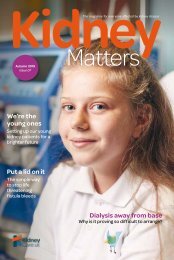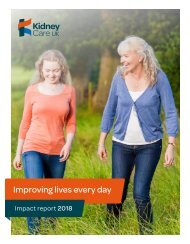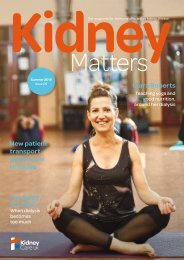Kidney Matters Issue 13 - Summer 2021
Kidney Matters is our free quarterly magazine for everyone affected by kidney disease. This issue includes features on music and mental heath, a transplant patient rediscovering a love of art to keep herself motivated, a teacher and CKD patient who helped anyone struggling with home-schooling their children during lockdown, medical articles about having a stent removed after a transplant, chronic kidney disease-mineral bone disease and how weight management can affect kidney patients following transplant. As well as this, the Kidney Kitchen explains how tomatoes can be safely included in your diet and shares a simple and tasty tomato pasta recipe especially prepared for kidney patients.
Kidney Matters is our free quarterly magazine for everyone affected by kidney disease.
This issue includes features on music and mental heath, a transplant patient rediscovering a love of art to keep herself motivated, a teacher and CKD patient who helped anyone struggling with home-schooling their children during lockdown, medical articles about having a stent removed after a transplant, chronic kidney disease-mineral bone disease and how weight management can affect kidney patients following transplant.
As well as this, the Kidney Kitchen explains how tomatoes can be safely included in your diet and shares a simple and tasty tomato pasta recipe especially prepared for kidney patients.
You also want an ePaper? Increase the reach of your titles
YUMPU automatically turns print PDFs into web optimized ePapers that Google loves.
17
Defining CKD-MBD
Guidelines for doctors define CKD-MBD as systemic
disorder of mineral and bone metabolism due to
CKD manifested by one or a combination of:
• Abnormalities of calcium, phosphorus,
parathyroid hormone, or vitamin D metabolism
• Or abnormalities in bone turnover, mineralisation,
volume, linear growth, or strength
• Or vascular or other soft-tissue calcification.
How common is CKD-MBD?
The abnormalities in blood levels of calcium,
phosphate and PTH that characterise CKD-MBD are
present in virtually everyone who is on dialysis. CKD-
MBD tends to develop when eGFR is less than 30ml/
min/1.73 2 (CKD stage 4), although subtle abnormalities
can be detected at earlier CKD stages. Generally, the
worse the kidney function and the lower the eGFR, the
greater the likelihood of CKD-MBD.
CKD-MBD is not the same as osteoporosis, another
slowly developing condition that affects the structure
and strength of the bones. Osteoporosis is caused
by age-related changes in bone remodelling, in which
breakdown of old bone outpaces formation of new
bone. Osteoporosis affects both women and men,
but women have a higher risk due to loss of oestrogen
hormone at the menopause.
“Kidney patients have the same risk factors for
osteoporosis as the rest of the population, so it is
possible to have both CKD-MBD and osteoporosis—
for example, if you are a post-menopausal woman on
dialysis. It can be difficult to differentiate between
the two conditions, and most kidney specialists find
CKD-MBD challenging to diagnose definitively. This
is because our current tests to monitor and assess
CKD-MBD do not give us the full picture of what is
happening to the bones and the blood vessels,“
comments Colin.
How do I know that I have CKD-MBD?
Subtle changes that indicate CKD-MBD can be
detected on X-ray. However, routine X-rays are not
recommended, because they subject people to
unnecessary radiation and the results are unlikely to
change treatment.
The gold-standard investigation to confirm CKD-MBD
is a bone biopsy, in which a doctor uses a special
needle under X-ray guidance to take small sample of
bone for examination under microscope. However,
bone biopsy is rarely used to diagnose and monitor
CKD-MBD because it is invasive and potentially painful,
and is again unlikely to affect the choice of treatment.
Colin adds: “Other possible indications of CKD-MBD are
complications such as bone pain, low-impact fractures,
muscle aches and pains, calcium deposits in the blood
vessels that can reduce the blood supply to that part
of the body including the blood vessels around the
heart (coronary arteries), calcium deposits on heart

















